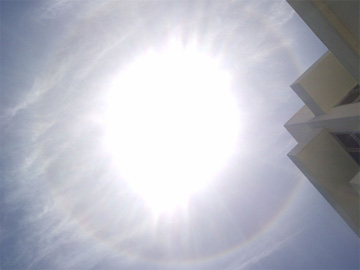For about an hour at mid-day in the city yesterday persons could be seen walking, their heads upturned, nose in the air, staring at the sky in awe.

No, it wasn’t a bird, a plane or an angel. It was a halo around the mid-day sun and it generated a buzz among passers-by, many of whom did not know what it was. The atmospheric halo seen yesterday, also called a rainbow ring for obvious reasons, is not altogether rare and the 22 degrees circular halo seen yesterday, are seen all over the world and throughout the year.
Atmospheric halos are formed by the sun shining through ice crystals in the upper atmosphere. The crystals refract the light. “This bends the light away from the sun”, former Head of Department of the Natural Sciences faculty at the University of Guyana, Alfred Bhulai said. A halo is formed.
More scientifically, a halo is the ring of light that seems to encircle the sun or moon when veiled by cirrus clouds. There are many types of optical halos, but they are mostly caused by ice crystals in cold cirrus clouds located high (5-10 km or 3-6 miles) in the upper atmosphere. The particular shape and orientation of the crystals is responsible for the type of halo observed. Light is reflected and refracted by the ice crystals and may split up into colours because of dispersion, similarly to the rainbow.
Halos usually occur whenever the sky is wisped or hazed with thin cirrus clouds. Cirrus are thin, wispy clouds composed of ice crystals and often appears as patches or strands. It is one of the three basic cloud forms (the others are cumulus and stratus) and is also one of the three high cloud types. The most commonly observed halo is one that forms at a 22 degrees radius, although another one at 46 degrees radius may also be seen.
How long it last depends on the ice crystals – they may move horizontally in wind, or up or down depending on convection currents. The one yesterday lasted for about an hour and many persons snapped photographs of it.
It should be noted that when looking for/at halos, one should always shield both eyes from the sun and never stare close to it even for a moment. Preferably, hide the sun behind the edge of a building or post. Care should be taken when photographing halos if the unshielded sun is in the field of view. It is dangerous to look at the sun through some camera viewfinders.
Bhulai said that he had observed such atmospheric halos occurring here about four to five times per year.





